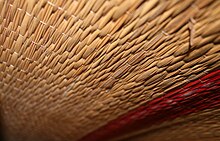Mat (underlay)




Underlay mats are among the oldest seating and sleeping options since the beginning of human settlements . They can be found in most of the cultures of Africa, Asia, Europe and America, but older specimens have not been preserved due to the natural materials used; however, the basic manufacturing techniques have hardly changed for millennia.
In contrast to the later blankets etc. made using weaving technology , woven mats were usually made from regionally available and largely unprocessed natural materials (later also from textile strips); the braiding creates either a checkerboard or (more often) diamond pattern .
function
Underlay mats offered protection against cold and excessive heat as well as against soil insects and rising soil moisture . At first they were probably only reserved for the respective home owners, but other family members soon began to enjoy their many advantages. They were regularly rolled out at night to form an insulating sleeping pad. You could also cover entire rooms with mats, but that rarely happened.
Mats still fulfill all of these functions in many regions of the world, but they are mostly made from plastic strips. Smaller mats made of natural materials can sometimes be found as underlays for plates and cups. Today's "beach mats" are still reminiscent of earlier materials and functions.
Manufacturing
Lacing mats
Underlay mats, which are variable in size, were originally made from grass , bast fibers or rushes that were laid next to one another and connected with cords, etc. , later made from thin twigs or thinly cut bamboo or rattan strips ; Because of their low weight, they could quickly be laid out elsewhere or rolled up and taken with you. Mats made from (old) strips of fabric are light and flexible, but usually not very durable.
Woven mats
Woven mats made from palm leaves or sedge (Cyperus) are at least as light, but also brittle; rolling up or rolling out is therefore hardly possible. During the day they can only be stacked on top of each other or placed one behind the other on the wall.
Hanging mats
Hanging mats on doors and windows and as room dividers protect against unwanted looks and / or against sunlight, wind, drifting sand , insects, birds etc. Depending on the material and weather conditions, they can be rolled up and tied into a roll within seconds.
symbolism
In Copán , Honduras , there is a so-called “council house” (near popol) with mat motifs over the three entrances. Some of the Mayan rulers in Copán and elsewhere wear small rolled-up mats on their waist belts; in this way they identify themselves as “masters of the mat”. Many antique diamond patterns are derived from woven mats and / or can be interpreted as "stone mats".
